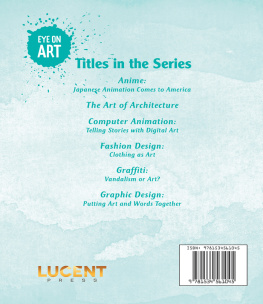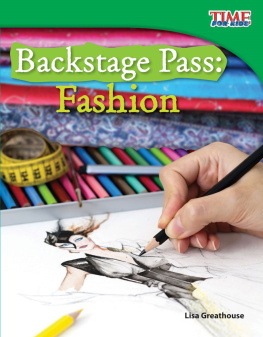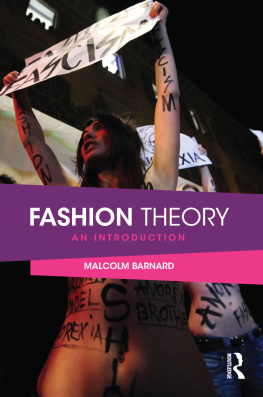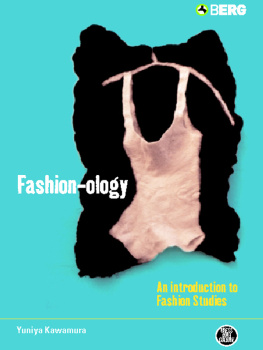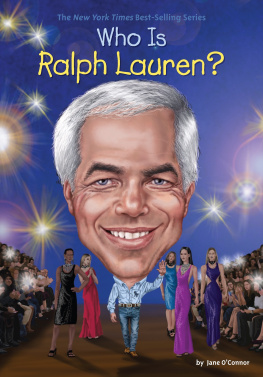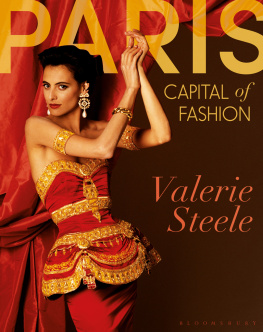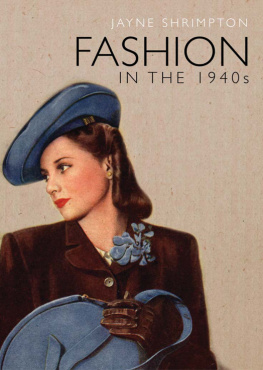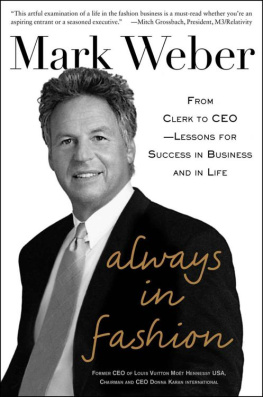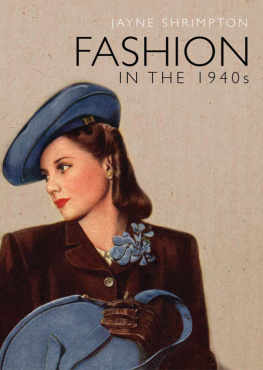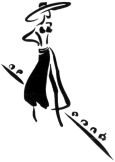JUST LIKE THE fashion designer who bows alone on the runway, the book author is rewarded with a byline in boldface, when backstage there are many individuals whose deeds are indispensable to such endeavors.
I cannot adequately expess my gratitude to the scores of designers, retailers, publicists, consultants, and analysts whom I have enlisted during the past ten years that I have covered the fashion beat at The Wall Street Journal, especially those who weighed in during the nearly three years I spent researching and writing this book. Their trust and willingness to open the kimono have been a godsend in my quest to get the story right. I hope that I have succeeded in depicting their situations in a truthful and even-handed way.
I wish to acknowledge my agent, Joel Fishman, of Bedford Book Works, who first approached me to write this book and was a terrific sounding board and hand holder along the way. Joel introduced me to Paul Bresnick, executive editor at William Morrow, and his associate editor, Ben Schafer, who demonstrated their unflagging support and keen interest in my project. Two skillful freelance editors, Charles Flowers and Ed Shanahan, helped me to whip the manuscript into shape.
The Wall Street Journal, my professional home for the past fifteen years, is a repository of Americas best reporters and editors who continue to challenge and inspire me. Managing editor Paul Steiger generously granted me a twenty-month book leave and put me back on the fashion beat when I returned.
I am fortunate to have many close relationships at the Journal, including Johnnie Roberts (now at Newsweek), Alexandra Peers, and Wade Lambert, who came through in the crunch with critical suggestions, while veteran book writers George Anders, Jeffrey Trachtenberg, and Roger Lowenstein shared their experiences. Reporter Wendy Bounds kept the Journals fashion coverage lively during my absence. Bruce Levy, the Journals most valuable researcher, unearthed valuable nuggets, and computer whiz Phil Chan rescued my lost files on several occasions. Among my Journal colleagues who deserve my thanks are copy editor Betty Hallock, and editors Cynthia Crossen, Ellen Graham, David San-ford, Carolyn Phillips, Ron Alsop, Mike Miller, Laura Landro, and Dan Hertzberg.
Jane Berentson, a lifelong fashionista and big-picture editor, volunteered to help me map out the book and kept me on track. Veteran fashion writer Cathy Horyn is the worlds most unselfish reporter, whose extraordinary talents are matched only by her friendship of a decade.
Ive sharpened my fashion instincts by tapping the experts: Caroline Rennolds Milbank, Vicki Ross, and at the Costume Institute at the Metropolitan Museum Richard Martin, Deirdre Donohue, and Stephane Houy-Towner. I miss my mentor, the late Alan Millsteinthe Quotronwho knew the ways of Seventh Avenue better than anybody else. Joan Kron, who first carved out the fashion beat at the Journal in 1983, came through and hooked me up with Andrea Miller, a skilled transcriber, and editor Ed Shanahan. In Paris, Pamela Golbin, of the Muse de la Mode et du Textile, was also an invaluable resource.
Several leading fashion journalists shared their astute insights: Bernadine Morris, Constance White, Robin Givhan, Mary Lou Luther, Ruth La Ferla, Christy Ferer, Elizabeth Snead, Anna Wintour, the late Elizabeth Tilberis, and WWDs Patrick McCarthy, who permitted me to use the archives at Fairchild Publications.
Every nonfiction work benefits from having a broad range of key sources, and I am indebted to them all, including those who asked not to be named. My profile subjects kindly granted me extensive interviews and their staffers obligingly responded to my many inquiries: Ralph Lauren, Tommy Hilfiger, Emanuel Ungaro, Giorgio Armani, Zoran, Dan Skoda at Marshall Fields, Isaac Mizrahi, John Idol, and Robert Gray.
I gleaned pertinent insights from many others, listed here in no particular order. In New York: Bud Konheim, Joel Horowitz, Philip Miller, Victor Lipko, June Horne, Audrey Smaltz, Gary Galleberg, Hamilton South, Mallory Andrews, Jim Fingeroth, Dennis Walker, Jerry Chazen, Rick Rector, Bill Blass, Henry Hacker, Josie Esquivel, Faye Landes, Michael Toth, Christy Ferer, Carl Steidmann, Domenico De Sole, Maryanne Wheaton, Arnold Simon, Stephen Ruzow, Arnold Aronson, Allen Questrom, Terry Lundgren, Catherine Fisher, Michael Sondag, Craig Reynolds, Silas Chou, Lawrence Stroll, Kim Johnson Gross, Jeff Stone, Martha Nelson, Lynn Wyatt, Grace Mirabella, Michael Clinton, Tom Julian, Ted Marlow, Michael Gross, and Hal Rubenstein.
In Paris: Carlo Valerio, Ferrucio Ferragamo, Laura Ungaro, Rene Ungaro, Nino Cerruti, Ralph Toledano, Karl Lagerfeld, Didier Grumbach, Robert Bensoussan-Torres, Bernard Arnault, Tom Kamm, Amy Barrett, Pier Filipo Pieri, Jacques Babando, Andr Leon Talley, Denise Dubois, Robert Forrest, and Jacques Mouclier.
In Milan: Pino Brusone, Kevin Doyle, Maria Sturani, Rosita and Tai Missoni, Aldo Pinto, Pierfilippo Pieri, and Luigi Maramoti.
In Chicago: Sharon Stangenes, Genevieve Buck, Dorothy Fuller, Sugar Rautbord, Teresa Wiltz, Judy Byrd, Homer Sharp, Phyllis Collins, Connie Jackson, Gloria Bacon, Gary Witkin, and Dayton Hudson Corp.s Michael Francis and Gerry Storch in Minneapolis.
In Los Angeles: Lisa Bannon, Wanda McDaniel, Michael Sharkey, and Bob Mackie.
Friends, indeed, are those who shared my pain and raised my spirits on the phone and through E-mails, and my tribe is the best: Wendy Urquhart (who came up with the idea for the book cover), Gay Young, Diane White, John Dwyer, Veronica Webb, Benjamin Borwick, Christine Bates, Peter Greenough, Chuck Stevens, Kevin Merida, as well as my sister Genie Agins, her husband, Chris Nunes, and Aunt Dorothy Wilson. Back home in Kansas City where I grew up, Bette Dooley, my stylish next-door neighbor, taught me to love high fashion.
Finally, I count as my biggest blessing, my parents, Gene and Phyllis Agins, whose love, guidance, and sacrifices have allowed me to pursue my dreams.
TERI AGINS
S upermodel Naomi Campbell has a killer body, a sassy strut, and a $10,000-a-day attitude. Famous for being fashionably late for work, she has left more than a few designers in the lurch right before a big show, wondering whenor ifshe would appear. But the supermodel wasnt quite so cavalier when it came to Isaac Mizrahi, her buddy and the darling of Americas designers. Nobody lit up a runway the way Isaac did during the 1990s. His witty, high-energy fashion shows were always the highlight of the New York collections.
On the evening of April 10, 1997, Mizrahis fashion spectacle took place near Madison Square Garden, at the Manhattan Center on West 34th Street. At a quarter to six, with more than an hour to spare, the diva of the catwalks made her entrance, in sunglasses, $500 Manolo Blahnik stilettos, and a stunning spotted coat. On cue, bounding down the stage steps, emerged the man in black, Isaac Mizrahi, brandishing a Camel Light like a conductors baton.
There she is! Na-o-mi! he exclaimed, swooping in to buss her on both cheeks. Fab-u-lous. Mizrahi ooohed and ahhed, checking out her genuine leopard wrap. Evidently, the antifur era was over and out. Campbell was sporting the most politically incorrect of furs; leopards had been an endangered species since before she was born.


